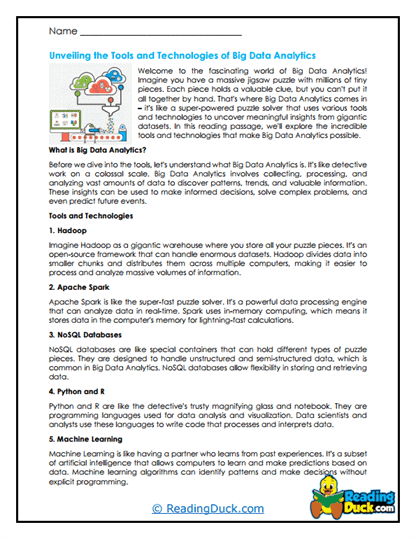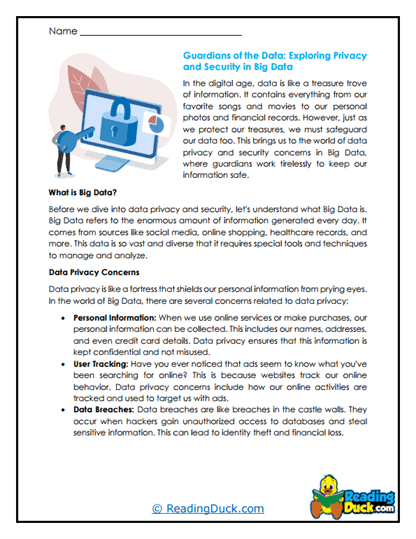Data Analytics Worksheets
About Our Data Analytics Worksheets
Our Data Analytics Worksheets are designed to introduce students to the fascinating world of data analysis and its applications. Data analytics involves the process of examining raw data to uncover patterns, draw conclusions, and support decision-making. These worksheets help students grasp fundamental concepts in data analytics, making a complex and highly relevant subject accessible and engaging.
In the Technology category, where this collection belongs, topics are organized into categories such as 3D Printing, Artificial Intelligence, Autonomous Vehicles, Blockchain and Cryptocurrencies, Cloud Computing, Cybersecurity, Data Analytics, Electric Cars, Quantum Computing, and The Internet. Each topic is chosen to reflect a broad spectrum of technological applications, ensuring there is something for every student to connect with and explore.
This collection contains several worksheet sets, each focusing on different aspects of data analytics. The structure of each worksheet set is as follows:
- Multiple Choice Questions: These questions test students’ understanding of key concepts related to data analytics, ensuring they can identify and apply foundational ideas presented in the reading passage.
- Short Answer Questions: Students are encouraged to articulate their understanding in their own words, promoting critical thinking and helping them internalize the material through written expression.
- Open-Ended Questions: These questions invite students to share their personal opinions, interpretations, and predictions related to data analytics, fostering a deeper connection to the topic and encouraging thoughtful reflection.
To assist educators, each worksheet includes an answer key. All of the worksheets are provided as PDF files, which can be easily accessed, viewed, downloaded, and printed for use in both classroom and home settings.
Understanding Data Analytics
Data analytics is the science of analyzing raw data to make informed decisions. It involves collecting, processing, and interpreting data to identify trends, patterns, and relationships. Data analytics is used in various fields, from business and finance to healthcare and sports, making it a versatile and valuable skill in today’s data-driven world.
Key components of data analytics include:
- Data Collection: The process of gathering data from various sources, such as surveys, sensors, databases, and online interactions. Effective data collection is critical to ensure that the data is accurate, relevant, and sufficient for analysis.
- Data Cleaning: Once data is collected, it often needs to be cleaned to remove errors, inconsistencies, and irrelevant information. This step is essential to ensure that the analysis is based on high-quality data.
- Data Analysis: This is the core of data analytics, where various methods and tools are used to examine the data. Techniques include statistical analysis, machine learning algorithms, and data visualization.
- Data Visualization: Presenting data in graphical formats such as charts, graphs, and maps makes it easier to understand and interpret the results of the analysis. Effective data visualization helps communicate insights clearly and compellingly.
Applications of Data Analytics
Data analytics has a wide range of applications across different industries and sectors:
- Business: Companies use data analytics to understand customer behavior, optimize marketing strategies, and improve operational efficiency. For example, retailers analyze sales data to determine which products are most popular and when to stock them.
- Healthcare: In healthcare, data analytics is used to track patient outcomes, identify risk factors for diseases, and improve treatment protocols. For instance, hospitals use data to predict patient readmission rates and reduce unnecessary readmissions.
- Sports: Coaches and teams use data analytics to evaluate player performance, develop game strategies, and even prevent injuries. By analyzing data from games and training sessions, they can make informed decisions to enhance performance.
- Education: Educational institutions use data analytics to monitor student progress, identify areas for improvement, and personalize learning experiences. Data can reveal patterns in student behavior that help educators tailor their teaching methods.
- Finance: Financial institutions rely on data analytics to detect fraudulent activities, assess credit risk, and make investment decisions. For example, banks analyze transaction data to identify unusual patterns that could indicate fraud.
- Public Policy: Governments use data analytics to make informed decisions about public policy, resource allocation, and social programs. Data-driven approaches help policymakers understand the impact of their decisions and optimize public services.
Types of Data Analytics
There are several types of data analytics, each serving a different purpose:
- Descriptive Analytics: This type focuses on summarizing past data to understand what has happened. It involves techniques like data aggregation and data mining to provide insights into historical trends.
- Diagnostic Analytics: This type aims to understand the reasons behind past events by analyzing data in more detail. It answers the question, "Why did this happen?" and often involves identifying correlations and patterns.
- Predictive Analytics: Predictive analytics uses historical data to make predictions about future events. It employs statistical models and machine learning techniques to forecast outcomes such as sales trends or customer behavior.
- Prescriptive Analytics: The most advanced type, prescriptive analytics, suggests actions based on the analysis of data. It goes beyond predictions to recommend specific courses of action to achieve desired outcomes.
By exploring these concepts through the data analytics worksheets, students can develop a solid understanding of how data is used to inform decisions, predict outcomes, and drive innovation across various fields.
Creative Uses for These Worksheets
To help students engage more deeply with the topic of data analytics, here are some creative and effective ways to incorporate these worksheets into classroom activities or homeschool lessons:
1. Real-World Data Projects
- Assign students to collect and analyze real-world data from sources such as weather reports, sports statistics, or social media trends. Have them present their findings and insights, explaining how the data was collected, cleaned, and analyzed.
2. Cross-Curricular Integration
- Math and Statistics: Integrate data analytics with math lessons by teaching students how to calculate averages, medians, and standard deviations. Use real data sets to practice these concepts in a practical context.
- Science: In science classes, students can analyze data from experiments or environmental studies. For example, they could track temperature changes over time and use data analytics to identify patterns and make predictions.
3. Data Visualization Projects
- Encourage students to create their own data visualizations using software tools or by hand. They can design charts, graphs, or infographics to present data in a visually appealing and informative way.
4. Data Storytelling
- Have students create a narrative around a data set, telling a story that explains the data and its implications. This could involve writing a report, designing a presentation, or creating a video that combines data with storytelling techniques.
5. Data-Driven Decision Making
- Organize a classroom activity where students must make decisions based on data. For example, they could analyze sales data to decide which products a store should stock or use customer feedback data to improve a service.
6. Guest Speakers and Virtual Field Trips
- Invite data analysts or professionals working in data-driven fields to speak to students about their work. Alternatively, organize virtual field trips to companies or organizations that use data analytics, giving students a firsthand look at how data is used in different industries.
7. Interactive Data Challenges
- Host data challenges where students compete to solve problems using data. These challenges could involve analyzing data sets to answer specific questions or using data to create predictive models.
8. Collaborative Group Projects
- Assign group projects where students must work together to analyze a complex data set. This could involve dividing the data into different sections, with each group member responsible for analyzing and presenting their findings.
9. Ethical Discussions
- Engage students in discussions about the ethical implications of data analytics, such as privacy concerns, data security, and the potential for bias in data analysis. Encourage them to think critically about the responsibilities that come with handling data.
10. Creative Writing and Reflection
- Have students write essays or reflective pieces on how data analytics impacts their daily lives. They could explore topics such as how companies use their data, the benefits and drawbacks of data-driven decision-making, or the future of data analytics.
By using these Data Analytics Worksheets creatively, educators can help students build a comprehensive understanding of data analytics and its significance in the modern world. These worksheets provide a versatile and accessible resource for exploring one of the most important areas of technology, equipping students with the knowledge and skills needed to navigate the data-driven landscape of the future.









